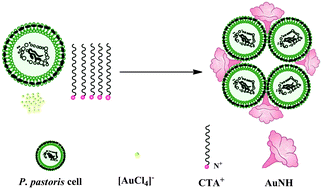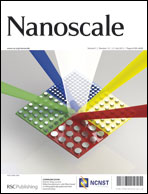Closely packed, size-controllable and stable Au nanohorns (AuNHs) that are difficult to synthesize through pure chemical reduction are facilely synthesized using a microorganism-mediated method in the presence of hexadecyltrimethylammonium chloride (CTAC). The results showed that the size of the as-synthesized AuNHs could be tuned by adjusting the dosage of the Pichia pastoris cells (PPCs). The initial concentrations of CTAC, ascorbic acid (AA) and tetrachloroaurate trihydrate (HAuCl4·3H2O) significantly affected the formation of the AuNHs. Increasing the diameters of AuNHs led to a red shift of the absorbance bands around 700 nm in their UV-vis-NIR spectra. Interestingly, the AuNH/PPC composites exhibited excellent Raman enhancement such that rhodamine 6G with concentration as low as (10−9 M) could be effectively detected. The formation process of the AuNHs involved the initial binding of the Au ions onto the PPCs with subsequent reduction by AA to form supported Au nanoparticles (AuNPs) based on preferential nucleation and initial anisotropic growth on the platform of the PPCs. The anisotropic growth of these AuNPs, which was influenced by CTAC and PPCs, resulted in the formation of growing AuNHs, while the secondary nucleation beyond the PPCs produced small AuNPs that were subsequently consumed through Ostwald ripening during the aging of the AuNHs. This work exemplifies the fabrication of novel gold nanostructures and stable bio-Au nanocomposites with excellent optical properties by combining microorganisms and a surfactant.

You have access to this article
 Please wait while we load your content...
Something went wrong. Try again?
Please wait while we load your content...
Something went wrong. Try again?


 Please wait while we load your content...
Please wait while we load your content...